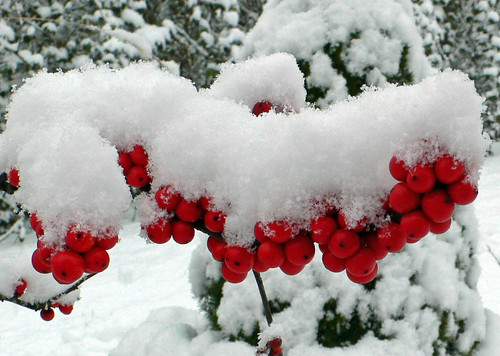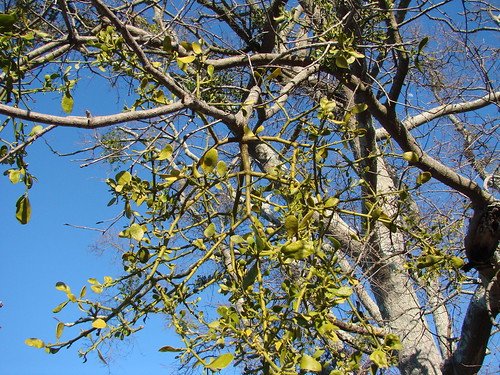
TheGardenLady received this question from Sally:
Are there any other Christmas themed plants other than the mistletoe?
There are numerous Christmas themed plants and there is a long and interesting history of the reasons for the use of these plants during the holiday season. Many of these holiday themed plants are used in the US today. TheGardenLady will touch on some of the most popular Christmas plants. Common holiday plants are listed in this website, where there is a lot of interesting information given besides the list of holiday plants. In other parts of the world they may also use different plants.
The first Christmas plant materials, as told in the New Testament, were Frankincense and Myrrh. Both are resins of trees used as incense or fragrances. They were the most expensive substances in early history and were therefore the highest tribute offered. Both were and are used today as fragrances. Franckincense is from the Boswellia sacra tree and Myrrh is from the Camphor tree, Commiphora myrrha. They are are found in Oman, Yemen and the Northeast part of Somalia. Oman still produces perfumes made of Frankincense or on Amazon.com you can get soap made of Frankincense and Myrrh- All Natural Bath Soap – Frankincense & Myrrh Zum Bar Soap by Indigo Wild, 3oz. or Frankincense and Myrrh can be bought as fragrant oils or for incense.
Some of the plants used in the Christmas celebration today were used originally by pagans. Some of the themed plants, like the Christmas tree, came about during the early Christian period. Many of the Christmas plants used in the US were brought to the US by the immigrant settlers. And some Christmas plants, like the Christmas Cactus (Schlumbergera x buckleyii) or the Poinsettia (Euphorbia pulcherrima), which were discovered in the New World, have become relatively new symbols of Christmas because they bloom at Christmas time. The Poinsettia which was discovered in Mexico where it is known as the Flores de Noche Buena, Flowers of the Holy Night not only blooms around Christmas time but were basically red and green, (now the newer hybrids come in other colors) so it is easy to see why it became associated with the
Christmas holiday. Poinsettia, Christmas Cactus and Cyclamen Holly How to Grow
Mistletoe and Holly – see here and here and here.

Myths and legends have grown up about the use of the plants for the Christmas holiday. Some of the plants have more than one myth associating it to the Christmas story.
Mistletoe
- Mistletoe closer up by Martin LaBar
Traditions involving mistletoe date back to ancient times. Druids believed that mistletoe could bestow health and good luck. Mistletoe also played a role in a superstition concerning marriage where it was believed that kissing under the mistletoe increased the possibility of marriage in the upcoming year.
American mistletoe (Phoradendron serotinum) can be found growing in deciduous trees from New Jersey and southern Indiana southward to Florida and Texas. It is the state flower of Oklahoma. Most mistletoe is harvested in Oklahoma and Texas.
Holly

The pointed leaves of the evergreen Holly (Ilex aquifolium found in Europe or Ilex opaca found in the US) represent the thorns of Christ’s Crown. The green leaves represent eternal life, and the red berries represent the blood of Christ. It is said that holly was used to make the crown of thorns.
Ivy (Hedera spp.) is another old Christmas symbol.
![]()

The significance of ivy, like holly and mistletoe, is based on pagan rituals. Ivy was a symbol of everlasting life in pagan religions. The Celts and Druids thought that just like ivy, the earth was everlasting and would persevere. It was a symbol of hope that spring would soon arrive. Ivy has the same meaning in Christian symbolism. It represents the everlasting life of Christ.
The Laurel plant (Laurus nobilis)
“Laurus nobilis” flowers (Alloro) by Luigi FDV
is another Christmas plant whereby both the pagan and Christian meanings are similar. Early Christians adopted the laurel leaf- also known as bay leaves -as their own, altering the meaning slightly to mean the triumph of humanity through the birth of Jesus. Both ivy and laurel leaves continue to be used in Christmas decorations, especially wreaths and garlands.
Rosemary (Rosmarinus officinalis)

is another plant with extensive holiday traditions, symbolism, and legends. Floors of churches and homes were strewn with the herb and the traditional boar’s head for the Christmas feast was decorated with rosemary.

Though today many different evergreen trees are used as Christmas trees- usually those from the Pinaceae – Pine family or the Cupressaceae – cypress family, local additions may use other plants. (How to pick the best evergreen tree for your area. The first tree used for Christmas decorations is believed to be the fir tree, probably pinus sylvestris that grows in Europe; but what is called the fir tree, the common name, can be one of between 45-55 species of evergreen conifers in the family Pinaceae that is in the genus Abies. See the history of xmas tree.
![]()
![]() Medieval Christmas Tradition
Medieval Christmas Tradition
The Christmas tree originally came from Latvia or Germany. In the early 16th century, Martin Luther is said to have decorated a small Christmas Tree with candles, to show his children how the stars twinkled through the dark night. The early trees were biblically symbolic of the Paradise Tree in the Garden of Eden. Decorations were food items, like apples, symbols of Plenty, and flowers, originally only red (for Knowledge) and White (for Innocence).
The tree custom traveled to England and became especially popular under the reign of Queen Victoria. Trees had decorations that included cranberry garlands. Around this time, the Christmas tree was spreading into other parts of Europe. The Mediterranean countries were not too interested in the tree, preferring to display only a Creche scene. Italy had a wooden triangle platform tree called a ‘CEPPO’. This had a Creche scene as well as decorations.
Immigrants brought the tradition to the US though it was not until communications really got going in the 19th century that the custom of the Christmas tree began to spread from isolated German communities throughout the country. Thus references to decorated trees in America before about the middle of the 19th century are very rare.
Apples

Apples are a symbol of the holiday season that is used during the holiday. They are used in the wassail bowl drink. Wassailing is the tradition of going from house to house caroling, eating, drinking, and socializing with friends and relatives. Wassailing, however, was originally an important part of a horticultural ritual. In England, it focused on the apple orchards. The purpose was to salute the trees in the dead of winter to insure a good crop for the coming year. The date varied across the 12 days of Christmas. If done formally, the wassail procession visited the principal orchards of the area, caroling as it went. In each orchard, major trees were selected and cider or liquor was sprinkled over their root systems.
What trees were used for Yule log

The use of the Yule Log spread all over Europe. A tree is chopped down and the bark is removed. It is brought into the house to burn. In England they use/d the oak tree or a bunch of ash twigs that burn. In Scotland they use/d the birch tree and in France they use/d the cherry tree.
The Cherry Tree

In central and northern Europe it is the custom to break off a branch of a cherry tree at the beginning of Advent (Advent from the Latin word adventus, means “coming” and is the period immediately preceding Christmas.) and keep it in water in a warm room. The flowers burst into bloom at Christmas time.
Hawthorn

Glastonbury thorn (Crataegus monogyna ‘Biflora’) The Glastonbury thorn is connected with Christ’s death as well as his birth. Legend has it that Joseph of Arimathea came to Britain to spread the message of Christianity. As he lay down to rest from his weary journey, he pushed his staff into the ground beside him. When he awoke, he found that the staff had taken root and begun to grow and blossom. From that day onwards – every Christmas Eve the white thorn buds and blooms.
There is a tradition in England that a branch of the Glastonbury Thorn is taken and displayed each year in Buckingham Palace.
Other Christmas Themed Plants
The Christmas Rose isn’t a true rose, but is the helleborus nigra which traditionally flowers in December at Christmas time, thus its name. It is considered another Christmas plant.

In Greek the Chrysanthemum means “golden flower,” but today many German families bring white chrysanthemums into their homes on Christmas Eve, following the tradition based on a German legend of sheltering the Christ Child.

In Lebanon families plant seeds of grain in small pots a month before Christmas so that when Christmas arrives the families have little pots of green to place around their Christmas tree.
In the Ukraine they bring a sheaf of wheat or didukh into their houses for decorations.
Paperwhite narcissus are thought of as Christmas plants because they can be forced to bloom for the holiday. They are especially enjoyed in Chinese dwellings as harbingers of spring.

In Australia where there are many plants not known in the Northern hemisphere, unusual plants are used as Christmas themed plants. December is summer in Australia so many of these plants are now in bloom. It would be interesting to learn about some of the legends and myths associated with these plants. See Christmas plants in Australia.
And even with all the traditionally themed plants for Christmas, horticulturalists are still creating new ones for the holidays. Ornamental Peppers are now being bred in brilliant holiday colors. The ones bred at New Mexico State University, the red and green pepper plants, are particularly appealing since the peppers can also be used in Christmas cooking. See peppers for xmas.
TheGardenLady invites readers of this blog to let her know what plant traditions are used in your house during this season of the year.



What is the Oklahoma state leaf?